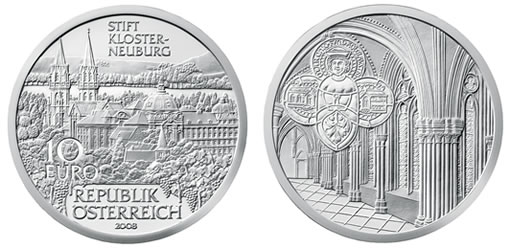The Abbey of Klosterneuburg coins are the 5th minted in the Austrian Mint’s silver commemorative series “Great Abbeys of Austria”
When one travels down the Danube, whether by river or by land, just before reaching Vienna one encounters the town of Klosterneuburg nestling around the ancient abbey on the heights overlooking the Danube Valley. Since the year 1114 canons regular have been living here according to the Rule of St. Augustine.

This abbey is the fifth coin in the Austrian Mint’s silver series “Great Abbeys of Austria” and will be issued on 16th April, 2008.
The Augustinian abbey of Klosterneuburg was founded in 1114 by Margrave Leopold III (who was subsequently canonised and ranks as the patron saint of Austria). The famous legend is that Leopold’s wife, Agnes, lost a precious scarf in the wind which Leopold himself found some years later while hunting.
A vision of the Virgin Mary is supposed to have instructed him to found an abbey on that spot. The legend is, of course, romance, although the scarf does still exist in actual fact. St. Leopold is buried in the crypt of the church under the winged altar known as the Verduner Altar, consisting of some 45 gilded and enamelled panels with scenes from the Bible and dating from the end of the 12th century.
The abbey almost died out in the time of the Reformation, but was restored and invigorated by Provost Caspar Christiani (1578-1584). In 1683 Turkish troops besieging Vienna also attacked Klosterneuburg, but Provost William Lebsaft together with the canons and townspeople managed to repulse them without outside assistance.
In 1730 Emperor Charles VI visited Klosterneuburg and decided to rebuild the abbey as a Baroque palace complex of four courtyards and seven crowned domes incorporating the Augustinian abbey with his own imperial residence on the model of the Spanish Escorial outside Madrid. The unexpected death of the Emperor in 1740 brought construction to a halt, and to this day Klosterneuburg remains an unfinished masterpiece of Baroque architecture with only one courtyard completed.
The greatest threat to the abbey developed under the Nazis in the 20th century. In 1941 it was dissolved. Some of the canons were sent off as parish priests, some were sent into the army, some were incarcerated as resistance fighters, and some were executed.
Today Klosterneuburg has some 47 canons regular. It has recently renovated and enlarged its museum which attracts thousands of tourists every year. Like most abbeys in Austria, Klosterneuburg has important collections of artworks, books, coins and medals, as well as thriving vineyards.
The new silver € 10.- coin shows a view of the abbey on the obverse. One clearly sees the Romanesque and Gothic church. Behind it are the Baroque buildings and domes of the abbey. The crown of the Holy Roman Empire adorns the central copper dome.
The reverse shows the Gothic cloisters with a stained glass window of St. Leopold III in the foreground. As with previous coins in this series, the chief engraver of the mint, Thomas Pesendorfer, has managed to achieve an almost three dimensional depth in the line of the mediaeval cloisters.
The new coin with a face value of 10 Euro is struck in three qualities: proof (max. 60,000 pieces), special uncirculated (max. 40,000 pieces), and circulation quality (130,000 pieces) which are issued at face value through the banks. Each proof coin comes in an attractive box with a numbered certificate of authenticity, while the special uncirculated version is sold in a colourful and informative blister pack.
The series “Great Abbeys of Austria” will conclude in October with a coin for the Benedictine abbey of Seckau in Styria.
# # #
Coin specifications for 10 euro, "The Abbey of Klosterneuburg"
| Type: | Silver, Ag 925 |
| Finish: | Frosted Proof, Special Uncirculated or Circulation |
| Edge: | Plain |
| Diameter: | 32 mm |
| Weight: | 17.3 g |
| Fine Weight: | 16 g |
| Mintage: | 130,000 (circulation); 40,000 (special uncirculated); 60,000 (proof) |
| Face Value: | 10 euro |
| Designer: | Thomas Pesendorfer |
About the Austrian Mint
The Austrian Mint is situated in the heart of Vienna and is the official minting authority for Austria with a 800 year history.
The Mint is the source for all Austrian Euro and Cent coins, whether they are intended for shopping, as an investment or for collection. Before the Euro, the Schilling and Groschen coins were minted, and before that – during the monarchy – Crowns, Guilders and Ducats were struck by the Austrian Mint.
The company is located close to the centre at the Vienna Stadtpark in a Biedermeier building erected under Emperor Ferdinand I. from 1835 to 1837. Today it accommodates one of the most modern mints in the world.





